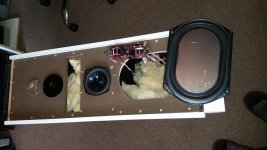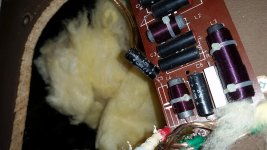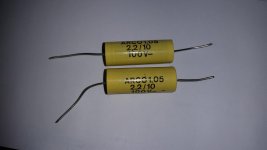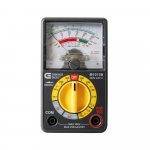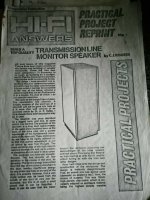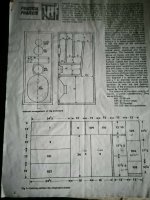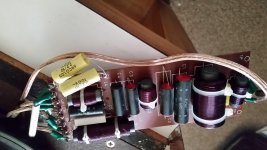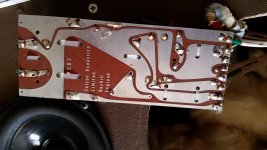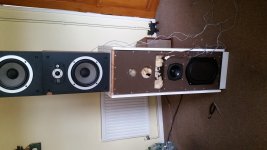Hi There
I recently brought a pair of home made T Line speakers from a well known auction site .. And i made the mistake of trusting some one ..
Short story they are 4way .. and on one speaker the top 2 tweeters are silent .. here are some photos .. As you can see one capasitor has exploded ... I think it is 4.7 mfd I have 2 old yellow 2.2 mfd
So here are my questions
1.. Will I cause any harm if i swap the 4.7 for the 2 x 2.2 caps
I was hoping to do this as a tempory measure to test for other problems . like are the tweeters knackered ? etc
2 how likely is it that one blown cap would effect the 2 tweeters and be the only problem .. Or does a blown cap mean more damage else where ??
All help greatly appreciated
I recently brought a pair of home made T Line speakers from a well known auction site .. And i made the mistake of trusting some one ..
Short story they are 4way .. and on one speaker the top 2 tweeters are silent .. here are some photos .. As you can see one capasitor has exploded ... I think it is 4.7 mfd I have 2 old yellow 2.2 mfd
So here are my questions
1.. Will I cause any harm if i swap the 4.7 for the 2 x 2.2 caps
I was hoping to do this as a tempory measure to test for other problems . like are the tweeters knackered ? etc
2 how likely is it that one blown cap would effect the 2 tweeters and be the only problem .. Or does a blown cap mean more damage else where ??
All help greatly appreciated
Attachments
You would have to trace the circuit and see what the cap actually does... it may or may not be tweeter related.
The caps are Non Polarised types.
You can fit the two 2.2uF in place of the 4.7uF.
You could also test the tweeters by wiring each via one of the 2.2uF caps direct to the audio output of an amplifier.
If the cap really has 'exploded' rather than just disintegrated than that sounds bad news.
I would test the tweeter individually first. You can also do a resistance check on them to see if they measure open circuit.
The caps are Non Polarised types.
You can fit the two 2.2uF in place of the 4.7uF.
You could also test the tweeters by wiring each via one of the 2.2uF caps direct to the audio output of an amplifier.
If the cap really has 'exploded' rather than just disintegrated than that sounds bad news.
I would test the tweeter individually first. You can also do a resistance check on them to see if they measure open circuit.
Thanks Mooly ..
To test the tweeters I would have to disconect them from the circuit ?
And test them with my poundland avo meter .. I am not totally competent with the meter .. I should set it to read 200 ohms and then expect to see a read out of ???
but to swap the caps out as a temp measure .. I can simply cut and solder and listen to the responce .. So this option is more apealling with my lack of knowledge .. if it is unlikely to cause more damage
To test the tweeters I would have to disconect them from the circuit ?
And test them with my poundland avo meter .. I am not totally competent with the meter .. I should set it to read 200 ohms and then expect to see a read out of ???
but to swap the caps out as a temp measure .. I can simply cut and solder and listen to the responce .. So this option is more apealling with my lack of knowledge .. if it is unlikely to cause more damage
The old 4.7uF Elcap is a non polar electrolytic. These caps do not age well and all the Elcaps in your crossover are worth replacing.
A leaky electrolytic in a tweeter circuit would send more low frequency energy to the tweeter than normal so tweeter damage is possible.
Yes, as SJ says, your 2.2uF caps are non polar film types. My first step would be to substitute the two, wired in parallel, for the 4.7uF Elcap to see if that restores the working of the tweeters.
Report back after trying that and we will then guide you through testing the individual tweeters, if that proves to be necessary.
A leaky electrolytic in a tweeter circuit would send more low frequency energy to the tweeter than normal so tweeter damage is possible.
Yes, as SJ says, your 2.2uF caps are non polar film types. My first step would be to substitute the two, wired in parallel, for the 4.7uF Elcap to see if that restores the working of the tweeters.
Report back after trying that and we will then guide you through testing the individual tweeters, if that proves to be necessary.
You don't need to disconnect the tweeters, your meter should read a few ohms, about 6. The yellow caps are nonpolar, be sure to connect them in parallel to make 4.4uF
Thanks Scott
How did you test the tweeters?
Did you test their resistance with your multimeter and find that the tweeters were open circuit (infinite resistance)?
the meter doesn't move when i test them
I presume you're using an analogue meter?
I suggest you replace the faulty 4.7uF capacitor as suggested earlier.
To check if the crossover is then working as intended, use any spare drivers you have (they don't have to be tweeters) as temporary substitutes for your damaged tweeters.
Best to do this before investing a large sum of money in new tweeters.
I suggest you replace the faulty 4.7uF capacitor as suggested earlier.
To check if the crossover is then working as intended, use any spare drivers you have (they don't have to be tweeters) as temporary substitutes for your damaged tweeters.
Best to do this before investing a large sum of money in new tweeters.
Attachments
Great idea .. taI presume you're using an analogue meter?
I suggest you replace the faulty 4.7uF capacitor as suggested earlier.
To check if the crossover is then working as intended, use any spare drivers you have (they don't have to be tweeters) as temporary substitutes for your damaged tweeters.
Best to do this before investing a large sum of money in new tweeters.
So to do this I have an old set of 6 ohm 2 way speakers ...I presume you're using an analogue meter?
I suggest you replace the faulty 4.7uF capacitor as suggested earlier.
To check if the crossover is then working as intended, use any spare drivers you have (they don't have to be tweeters) as temporary substitutes for your damaged tweeters.
Best to do this before investing a large sum of money in new tweeters.
Do I have to isolate these from thier internal Xover or can i just connect to the terminals on the back of the 2way ?
It would be best to isolate and use the tweeters alone, but you should get away with just connecting to the terminals.
To pursue this further, you would have to supply details (make and model) of all the drivers and close up photos of the crossover network (component side and reverse).
Have you any information on the kit from which this loudspeaker was constructed?
To pursue this further, you would have to supply details (make and model) of all the drivers and close up photos of the crossover network (component side and reverse).
Have you any information on the kit from which this loudspeaker was constructed?
Seems your tweeters are dead, woofer looks fine, what about the midrange?
Is it inside its own sub-enclosure? ... even a heavy cardboard tube?
Post some picture.
Given the amateurism level shown in construction, I wouldn´t be surprised at it being mounted without isolation from "woofer space".
What about the other cabinet?
In principle you should replace all electrolytic caps in crossover(s), check midrange and find a couple tweeters.
Also check whether the crossover is actually 4 way or 3 way with 2 tweeters in parallel, I wouldn´t be surprised.
Is it inside its own sub-enclosure? ... even a heavy cardboard tube?
Post some picture.
Given the amateurism level shown in construction, I wouldn´t be surprised at it being mounted without isolation from "woofer space".
What about the other cabinet?
In principle you should replace all electrolytic caps in crossover(s), check midrange and find a couple tweeters.
Also check whether the crossover is actually 4 way or 3 way with 2 tweeters in parallel, I wouldn´t be surprised.
It would be best to isolate and use the tweeters alone, but you should get away with just connecting to the terminals.
To pursue this further, you would have to supply details (make and model) of all the drivers and close up photos of the crossover network (component side and reverse).
Have you any information on the kit from which this loudspeaker was constructed?
They are designed by CJ rogers . Kef B139 KEF B110 KEF T27 and the coles 4001. and this pair have a Xover
( presumed original ) from Falcon Acoustics ..
So .. At the mo I have a dead T27 no meter reading and no sound .... And a 4001 that reads 8 on the meter but no sound
I have sound from the other 2 drivers
Attachments
I presume you're using an analogue meter?
I suggest you replace the faulty 4.7uF capacitor as suggested earlier.
To check if the crossover is then working as intended, use any spare drivers you have (they don't have to be tweeters) as temporary substitutes for your damaged tweeters.
Best to do this before investing a large sum of money in new tweeters.
So after doing a temp replacment of the caps and trying your idea of temporary drivers I appear to have a 4 way xover that works ...
But I still have some doubts
I tested and retested the drivers in situ ... from the T27.. no responce and I have no worries or doubts
But the 4001 sound none .. meter reading in situ 8 and once removed it too has no reading ...
Now I've tried the meter on the xover ... the meter doesn't blink for the T27 circuit .... but the 4001 circuit has a short .. I think .. huh
All Ideas welcome and needed thanks
Attachments
Seems your tweeters are dead, woofer looks fine, what about the midrange?
Is it inside its own sub-enclosure? ... even a heavy cardboard tube?
Post some picture.
Given the amateurism level shown in construction, I wouldn´t be surprised at it being mounted without isolation from "woofer space".
What about the other cabinet?
In principle you should replace all electrolytic caps in crossover(s), check midrange and find a couple tweeters.
Also check whether the crossover is actually 4 way or 3 way with 2 tweeters in parallel, I wouldn´t be surprised.
Post 17 has the plans .. the cabs are double sided with extra bracing !! as per the design with cross bracing from side to side .... and side diagonal bracing... and then laminated with formica on the outside and painted with car body underseal on the inside .. all of which help to reduce the resonance apparently
You'll get funny readings around a crossover circuit depending on the layout. We'll need to see the actual circuit before commenting.Now I've tried the meter on the xover ... the meter doesn't blink for the T27 circuit .... but the 4001 circuit has a short .. I think .. huh
Also, to avoid damage to the amplifier, do not run the amplifier into the crossover without working drivers connected.
- Status
- This old topic is closed. If you want to reopen this topic, contact a moderator using the "Report Post" button.
- Home
- Loudspeakers
- Multi-Way
- help needed capasitor question
